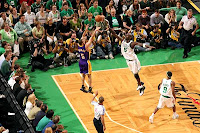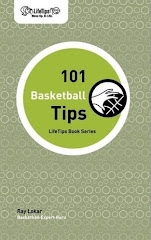*Pressure on the Ball*
A key is to always put pressure on the basketball. Don`t let an offensive player do anything with the ball--dribble, pass, or shoot--without having one of your hands trying to get into the way. If he is looking to pass, you may be able to get a hand on the ball or discouraging him from passing to an open player. That way for that split second when the post player is open, the passer may be deterred from executing the pass. This helps the post defender immensely.
Low Post Denial
*Low Post Defense-ball above the Free throw line*
If the ball is above the free throw line extended (imaginary line extending from the free throw line to the sideline), then you should deny on the high side (closest to 1/2 court. You should be chest to chest with the post player with your arm closest to the ball in the passing lane.
*Low post defense-ball is below the free throw line*
If the ball is below the free throw line try to get around the post player and "Full Front". We refer to an area called the red zone as an 8-foot to 10-foot imaginary semi-circle on the floor around the basket. The key to establishing good post defense is to beat the offensive player to their desired spot and get in proper position as you are coming down the floor to protect the "RED ZONE".The post player probably is not going to want you in this position, so it is a constant fight for position between the post player and defender. Your teammates will need to help you on any lob pass. Be active and try to AVOID contact. The post player will have more trouble "pinning" you in a position where they can receive the ball.
*Low Post Defense-he`s pushed you out of the RED ZONE*
The low post player might try to push you out after you "full front". If you get out too far you can release and get behind the post player, so that your feet are OUTSIDE of the key. Now you are between him and the basket and have him 12´-15´ away. You may be allowing him to get the ball but this makes it a tough shot for the offense AND you have rebounding position. The post is also closer to your help defenders, making it much easier for them to "dig" or "double" in the post.
*Get behind in the "SMILE"*
THIS IS OUR FAVORITE! We call the area from 12`-15`from the basket and just out of the RED ZONE the SMILE (diagram it on paper and you`ll see why)
Many times the 5 man is big and effective at the block, but not very good from 12` and out. Generally speaking they are not the most adept passers either. For this reason we will "bait" the offense into entering the pass to the post. We`ll initially fight to full front in hopes that the post battles for position (like they are taught to do). Then we`ll get behind. If the ball enters the post, we will either double or lock up on the perimeter (based on scouting).
*Sag off of the ball*
If you have determined thru scouting that the player with the ball is not a a very good shooter or is reluctant to shoot, it is possible to sag off of him defensively and NOT put pressure on the ball. By sagging in the direction of the post player with your hands up the defense has a much tougher pass into the post. Works in conjuction with playing behind after the post has pushed his defender out. Almost gives you someone in front and behind the offensive post player. If that outside player all of a sudden hits a couple of open shots-it`s tim eto change up and put pressure on the ball again.
*Double in the post*
There are many ways to double in the post. Some teams switch from game to game based on scouting. At the lower levels it may be more efficient to have one consistent style. Doubling from the wing who passed to the block allows the post player a clear vision to the help defender and a simpler pass back out to the perimeter. I like to leave that defender "locked up" on the wing. Doubling with another post defender leaves the post to post pass open and puts pressure on rebounding. That always concerns me. If all players are where they should be in relation to the BALL_MAN_LINE, it should be an easy double from the defender on(or near)the point or the weakside wing defender (who should be on the key by now). So I like to double from the top, with high hands, and have the weak side defender "zone up" in the middle. That "zone up" player is responsible to close out on the next pass. The "doubler" now rotates to the next offensive player.
This aggressive double and rotation sometimes causes a little confusion in an inferior passing post player and force them into turnovers.
Low post play is a constant battle for position. During this battle sometimes you may end up in a position where the post may catch the BALL. It is important at those times to be in a position to prevent him from making a good post move and getting a BASKET. And sometimes, when trying to deny the ball, the offense will simply make a good play and execute that perfect pass at just the right time and they may get a BASKET. That happens. But it better not be for lack of trying to deny them the BALL!
The defensive key during this battle is to keep from getting "pinned" in a position where the defense gives up "BALL & BASKET".
Bottom line: In the RED ZONE play Full Front-No Catch.
Once the offense tries to push you out beyond 8`-10`, Get behind them and SMILE - you have them right where you want them!
GET READY FOR GAME 7
-
The Indiana Pacers avoided an end to their season beating the New York
Knicks Friday night in Indy, 116-103. The series is tied 3-3. Game 7 is
Sunday, 3:30...
9 hours ago





















